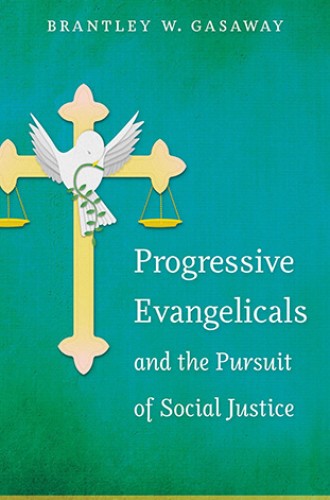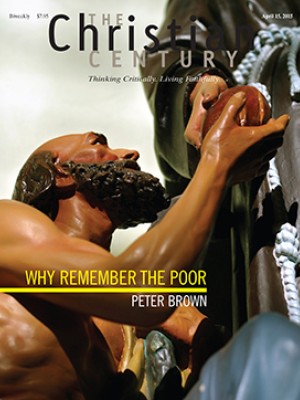Progressive Evangelicals and the Pursuit of Social Justice, by Brantley W. Gasaway
In 1985 evangelical activists marched through the streets of Washington, D.C. As the demonstration began, a spokesperson declared, “We’re showing that we are willing to pay the price, to sacrifice, to go to jail, if necessary, to draw attention to all the assaults on human life that are now so abundant.” By the end of the protest, police had arrested nearly 250 marchers for civil disobedience.
To those who assumed that the reference to human life derived from a singular animus against abortion, the march’s route seemed bizarre. Activists stopped first at the White House to pray for “an end to the arms race and for the poor, its primary victims.” Outside the Soviet embassy they prayed for the people of Afghanistan, “whose country has been brutally invaded by another arrogant superpower.” At the Supreme Court they protested the “barbaric practice” of the death penalty. Not until their final stop at the Department of Health and Human Services did marchers intercede for unborn children.
Read our latest issue or browse back issues.
In his survey of theologically conservative but politically progressive evangelicalism, Brantley Gasaway astutely examines the rally’s idiosyncratic platform. He contends that Peace Pentecost—and the broader evangelical left that carried it out—offered a coherent social agenda. Grounded in a “public theology of community,” it stood in stark contrast to the pervasive individualism of midcentury evangelicalism. The prophetic Jim Wallis of Sojourners magazine and the pastoral Ron Sider of Evangelicals for Social Action contended that sin expresses itself in more complex ways than person-to-person racism, violence against the fetus, and pornography.
These evangelicals declared that injustice often takes a social shape. Racism, which Sojourners called “America’s original sin,” could be seen in systems such as apartheid and housing policies. Sexism was perpetuated through cultural language and male privilege. None of these structural critiques demanded a progressive theology. Instead, Wallis and Sider pled that a conservative hermeneutic of scripture demands social justice.
In Gasaway’s telling, movement leaders sought sensible solutions to intractable problems. They declared same-sex marriage a civil right but a religious wrong. Sider sought to explain poverty as a result of both bad culture and excessive capitalism. Sojourners pursued a pro-life pragmatism that aimed to limit but not completely outlaw abortions, through government programs that offered contraception. Such centrist proposals, they hoped, could appeal to constituents on both the left and the right.
So why did the Moral Majority carry the day instead? The political homelessness of progressive evangelicals proved more decisive than the appeal of a third-way approach. In the wake of Peace Pentecost, Jerry Falwell declared that Wallis “is to evangelicalism what Adolf Hitler was to the Roman Catholic Church.” Pro-choice women’s groups vilified progressive evangelicals’ pro-life position. Journalists just seemed confused. Attacked by secular and religious fundamentalists alike, progressive evangelicals were caught in a sharply divided party system not designed to consider third ways. An unsettling chapter on “the agony of abortion” narrates how Sider and Wallis alternately tried to avoid the issue altogether, guide their anguished constituency, placate Christian conservatives, and reassure pro-choice feminists that they weren’t women-haters.
It is a complicated story told with considerable skill. But the dilemmas of progressive evangelicalism were even knottier than Gasaway suggests. Despite being progressive, the evangelical left nurtured antipathy toward Jimmy Carter in 1976, revealing the antiliberal instincts of early leaders. Wallis nurtured new left sympathies. In Rich Christians in an Age of Hunger, the Anabaptist Sider criticized liberal hopes for unlimited economic growth.
Moreover, the evangelical left was much larger and more diverse than Sojourners, Evangelicals for Social Action, and The Other Side magazine. Reformed evangelicals associated with Calvin College, the Association for Public Justice, and the Institute for Christian Studies in Canada urged a less prophetic, more gradualist approach to social change. It was a rich and diverse movement, but theological differences and ecclesiastical rivalry sometimes undercut the prospects for political success.
The fragmentation of the evangelical left stood—and stands—in stark contrast with the grand narrative of the Christian right. In that tale of declension, America once stood tall as a bastion of democratic, capitalistic, Christian light to the world, but now teeters on the precipice of secular humanism. The rescue mission articulated by the religious right proved to be a compelling political strategy in the context of racial fear, a growing federal government, and the cold war.
Perhaps progressive evangelicalism could have thrived in an era before the demise of southern Democrats and the rise of polarizing below-the-belt issues like abortion and homosexuality. Many advocates point to such an era: the 19th century, when a radical evangelicalism pioneered abolition and women’s rights. Narrating the long history of evangelical politics, historian Randall Balmer contends that the religious right is the anomaly, not the evangelical left. Wallis, feeling a profound sense of displacement, often identifies himself as a 19th-century evangelical living in the 21st century.
Three decades after Peace Pentecost—and more than a century since the supposed golden age of progressive evangelicalism—Gasaway contends that the movement “stands as strong as ever.” Which is to say, not very strong at all. A close examination of Peace Pentecost’s ground troops, which featured a high level of mainline and Catholic participation, shows that the event’s evangelical image may have been inflated. If anything, conditions now may be worse than in the 1980s. The issue of abortion continues to roil the movement, and the debate over homosexuality may blow it apart entirely. Progressive evangelicals continue to be marooned between a Democratic Party driven by secular elites uninterested in practices of faith and a retrenched conservatism peddling a politics of fear. The evangelical left has indeed been left behind.







